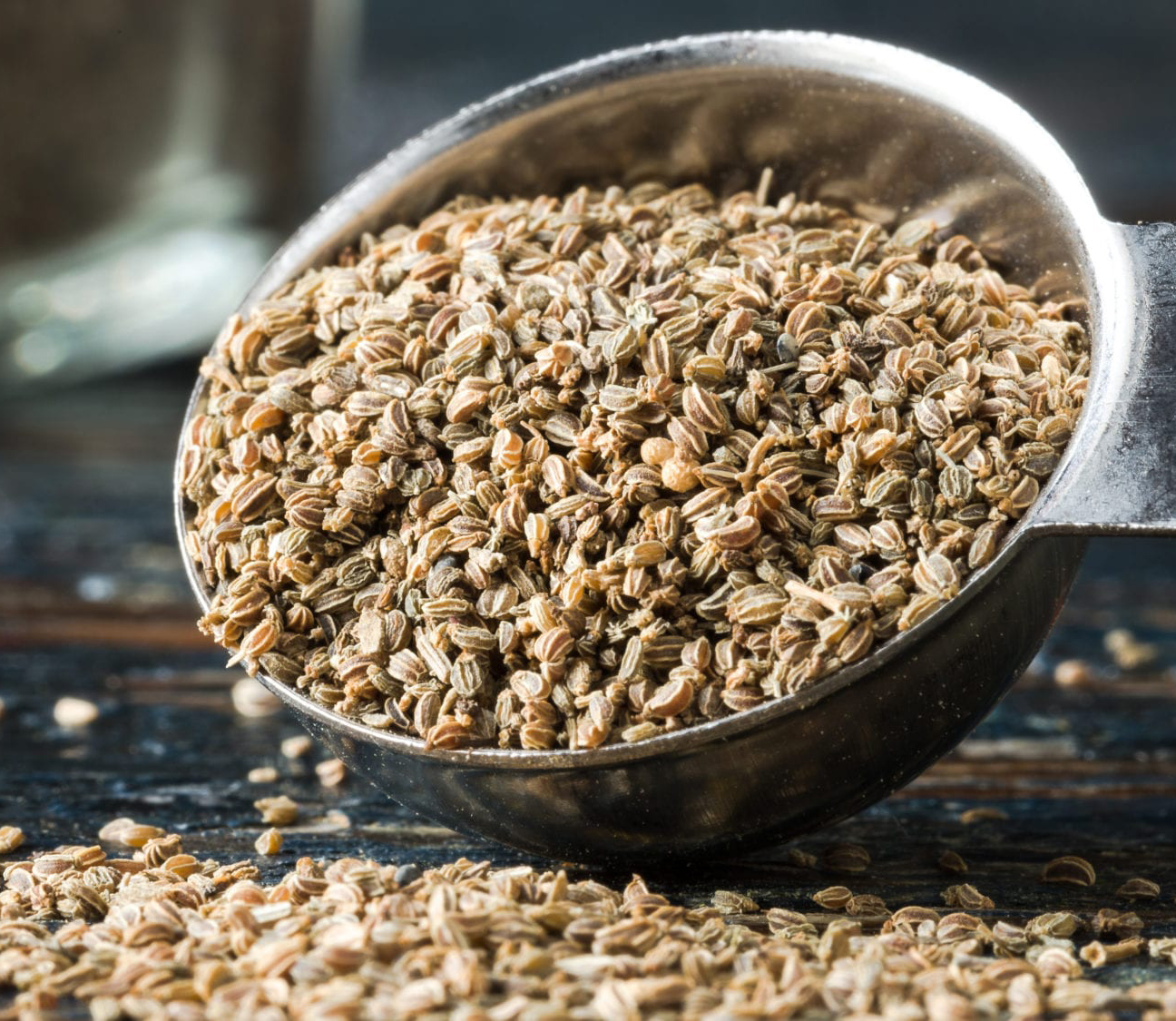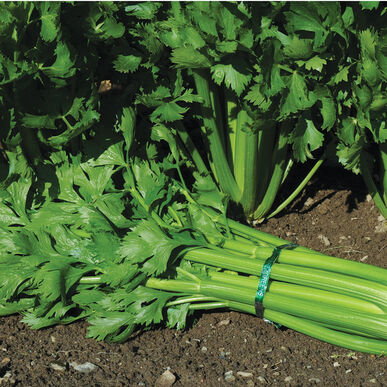Celery Seed Apium graveolens Essential Oil
Login to view prices
Common name: Celery
Latin name: Apium graveolens L
Family: Apiaceae (Umbelliferae)
Other names: Arabic: Karfas, Karafs; Czech: Celer; German: Sellerie, Eppich; English: Celeriac; French: Céleri ; Spanish: Apio; Swedish: Selleri
Description:
Apium graveolens L, the common celery, is a hapaxanthic herb, grown as a biennial and, unde certain conditions, as an annual.
From the beet-like tap-root (the uppermost part being a shoot) with its fibrous sideroots rises an aerial stem, 2 to 3 ft. high, branched and leafy, which bears compound umbels of small white flowers. The small fruit (or seed, as it is called commercially) consists of an ovate, dark brown cremocarp.
Possessing a characteristic, agreeable odor and a warm, aromatic, somewhat pungent taste, it is employed as condiment in the flavoring of food products. The seed also serves as birds’ food. The volatile or essential oil distilled from celery seed is used extensively for flavoring purposes.
Botanical Origin:
Common name: Celery
Latin name: Apium graveolens L
Family: Apiaceae (Umbelliferae)
Other names: Arabic: Karfas, Karafs; Czech: Celer; German: Sellerie, Eppich; English: Celeriac; French: Céleri ; Spanish: Apio; Swedish: Selleri
Description:
Apium graveolens L, the common celery, is a hapaxanthic herb, grown as a biennial and, unde certain conditions, as an annual.
From the beet-like tap-root (the uppermost part being a shoot) with its fibrous sideroots rises an aerial stem, 2 to 3 ft. high, branched and leafy, which bears compound umbels of small white flowers. The small fruit (or seed, as it is called commercially) consists of an ovate, dark brown cremocarp.
Possessing a characteristic, agreeable odor and a warm, aromatic, somewhat pungent taste, it is employed as condiment in the flavoring of food products. The seed also serves as birds’ food. The volatile or essential oil distilled from celery seed is used extensively for flavoring purposes.
Range & Habitat:
Celery, Apium graveolens L, is native to North America, South America and to Eurasia; as a wild plant it preferws NaCl and, therefore, grows in coastal regions. Although extensively cultivated as a vegetable, the dried ripe fruit are produced as a spice in the People’s Republic of China, France, India, Italy, Pakistan, the United States, and Great Britain.
The reported life zone of celery is 5 to 27ºC with an annual precipitation of 0.3 to 4.6 meters and a soil pH of 4.2 to 8.3. The plants thrive in deep sandy or loamy soils but require irrigation because of their shallow root systems. Plants are seeded or transplanted, and the compound white umbels, cross-pollinated by insects, are developed in the second year. Harvested plants are allowed to dry and are then threshed to remove seeds.
Planting & Cultivation:
Celery is planted by seed in nurseries during July and August. Late in the fall, before cold weather sets in, the young plants are transplanted into open fields.
Harvesting and Preparing for the Market:
The harvest takes place the following August and lasts about eight days. The plants are collected in the early morning; after several hours of drying, the material is ready for threshing.
The crude seed, after threshing is submitted to winnowing and finally sifted into various sizes. The whole procedure results in a number of products:
- Large, selected seed.
- Small seed.
- Wastage (chaff, winnowings) of seed.
- Dried umbels and leaves, after seed has been removed.
- Stalks and leaves from the whole herb.
An essential oil is obtained from seeds or seed chaff (lower quality) by a process of crushing and steam distillation
Yield of seed per Acre:
The yield of celery seed is apparently not very large, and varies considerably. From 300 to 600 lb. per acre have been reported.
Method of Extraction:
By Steam Distillation of celery seed
The volatile or essential oil contained in the seed is isolated by steam distillation. For this purpose, the seed should be crushed and, to avoid loss of oil by evaporation, immediately charged into the still. It is important that the seed be spread evenly on the perforated grids with which a still serving for seed distillation should be equipped.
The possibility of steam channeling must be prevented, for if this occurs only a part of the seed will be attacked by steam, and a poor yield of oil will result.
Distillation of one batch lasts from 10 to 12 hr. the distillation waters are usually redistilled (cohobated).
Yield of Oil:
The yield of oil varies from 1.90 to 2.45% for French seed, and from 2.14 to 2.50% from Indian seed. Generally oil yield is from 1.3 to 2.5%
American seeds are too high priced for distillation purposes.
NOTES:
- Oil of Celery Herb: The over ground parts also contain volatile oil e.g. the leaves. But the content of oil in the parts other than seed is so small that the cost of distillation is almost prohibitive. In order to obtain a more normal yield, the over ground parts of the plant would have to be distilled just before seed ripening, as is done with dill herb and parsley herb.
- Oleoresin Celery: the so- called oleoresins of celery is of increasing popularity among food producers. These oleoresins are prepared by extracting celery seed with volatile solvents (particularly alcohol), filtering and freezing the solutions, and driving off the alcohol in Depending on the solvent used, the consistency, appearance and flavor of the resulting oleoresins will vary.
Oleoresins not only possess the volatile top note of the essential oil, although in a much more dilute form but also the “body”, i.e. the fixed extractive matter of the celery seed. In other words, the oleoresins combine all flavor principles of the seed in the form of standardized and soluble products, which are easy to handle, and thus save the labor of preparing tinctures and extracts.
[1] Source: Simon, J.E., A.F. Chadwick and L.E. Craker. 1984. Herbs: An Indexed Bibliography. 1971-1980. The Scientific Literatureon Selected Herbs, and Aromatic and Medicinal Plants of the TemperateZone. Archon Books, 770 pp., Hamden, CT. The Essential Oils. By Ernest Guenther. 1950
Celery – Specific Uses and Applications
Use of seeds:
The brown, characteristically aromatic, pungent seed is used in salads, soups, stews, vegetable dishes, meat dishes, and celery salt (a mixture of table salt and ground celery seed).
Use of Celery Seed Oil:
The essential oil and oleoresin of celery seed are used as a flavoring or fragrance in liqueurs, perfumes, and cosmetics, such as soaps, creams, and lotions. The odor is produced by the anhydrides, sedanoid, and sedanomic.
Use of Vegetative parts
As a vegetable, celery is cultivated for the green and blanched leaf stalks (Apium graveolens L. var. dulce [Mill.] Pers.), or, to a limited extent, the edible thickened roots and crowns (Apium graveolens L. var. rapaceum [Mill.] Gaud.-Beaup).
Medicinal Uses
As a medicinal plant, celery has been used as :
- an aphrodisiac
- anthelmintic
- antispasmodic
- carminative
- diuretic
- emmenagogue
- laxative
- sedative
- stimulant
- and tonic.
The plant is also used against:
- asthma,
- bronchitis,
- and rheumatism.
Precautions:
- Large amounts of the volatile oil can produce sedation and irritation that may be responsible for attributed antispasmodic properties.
- Celery is known to cause photodermatitis and contact dermatitis.
- Celery has also shown hypoglycemic activity.
- Myristicin found in the seed is chemically related to known carcinogens. Wild celery usually refers to Vallisneria spiralis , an aquatic perennial plant of the Hydrocharitaceae family.
However:
Celery seed is generally recognized as safe for human consumption as a spice, natural seasoning, and plant extract/essential oil
Notes:
- High specific gravity and a rotation below + 60º indicate that the oil was distilled from material containing chaff. These changes results from evaporation of low boiling terpenes, especially limonene, on the large surface of the broken chaff material. The odor and flavor of the chaff oil are harsher and coarser than those of the true seed oil.
- Oil of celery seed consists, roughly speaking, of a lighter and a heavier portion, the former being composed mostly of terpenes, the latter of oxygenated compounds. Occasionally it happens that during celery seed distillation the lighter and heavier fractions of the oil separate in the Florentine flask.
- The odor and flavor of the Indian oils are normal, but usually not quite as fine as those of oils distilled from French seed.
- The odor of oil of celery herb is entirely different from that of the seed oil, the former being more representative of the plant as such.
Adulteration & its Detection:
The oil is subject to much adulteration, especially with:
| Adulterant | Appropriate method for detection | Notes |
| Chaff oil | See the notes | |
| d-limonene (from concentration of sweet orange oil) | Since d-limonene is a natural constituent of celery seed oil, such additions are difficult to detect.
But a lowering of specific gravity and a slight increase of dextrorotation of the oil occur |
Additional information
| Weight | N/A |
|---|---|
| Dimensions | N/A |
| Oil Purity | 100% Natural & Pure without any chemical, flavor, food additive or carrier. |
| Ship from | Egypt |
| Country of Origin | Egypt |
| Cultivation Type | Organic Certified, Organic not Certified, Conventional |
| Oil Bulk Packaging | 180 kg Steel Drum, 25 kg HDPE Plastic Jerrycan, 50 kg HDPE Plastic drum |
| HS Code | 33012941 |
| CAS Number | 3720-16-9 |
| Oil Documentation Available | Allergen Free Certificate, Bovine Spongiform Encephalophathy (BSE) Certificate, Certificate of Analysis (COA), GMO Certificate, GRAS Status Statement, Halal Certificate, Herbal Origin Statement, KOSHER Certificate, Manufacturing Flow Chart, Material Safety Data Sheet (MSDS), Organic Certificate, Pesticide Residual Certificate, Researches & Studies, Technical Data Sheet (TDS), WADA Prohibited list Statement |
-
Login to view prices
-
Login to view prices
-
Login to view prices
-
Login to view prices
-
Login to view prices








